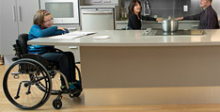Internal mini form
Contact Us Today
In a world that is built for people of typical abilities, a simple step in an entryway is something that doesn’t warrant a second thought. To a person that uses adaptive equipment to make their way from place to place, that small step is akin to a mountain if barriers exist. Accessibility is not as widespread as it needs to be, but legislation and community initiative are working together, worldwide, to ensure equal opportunity for access in many aspects of everyday life.
Getting where you – and your child – need to go
It’s not an uncommon sight to see children running up stairs to get into a recreation center, or a school, to take part in a leisure activity, or attend classes designed to prepare them for the future.
If those facilities were constructed after 1990, they are likely also to have an alternate method of entrance and exit; typically a long ramp with doors that can be opened using a button. Or better yet, the doors open automatically, much like one would see at a large retail establishment or grocery store.
This concept is known as accessibility. It’s a simple question with an answer that is sometimes unclear: Once a person with disabilities gets where he or she needs to go, will he or she be able to enter a facility or use a service?
More than 30 years ago, the U.S. Congress enacted the Americans with Disabilities Act of 1990, which was later signed into law by President George H.W. Bush. The landmark civil rights legislation – which was opposed by several powerful interest groups – outlined circumstances by which it is illegal to discriminate against people with disabilities.
The law provided a vital, much-needed framework that aimed to eliminate discrimination in employment, housing, transportation, telecommunications and public accommodations. For individuals with a disability, the law meant significant improvements; many facilities were adorned with ramps and electronic doors, individual with hearing loss or impairment could use TDD devices that made using the phone a possibility, and the perception of people with disabilities and their rights changed in most cases for the better.
More than two decades later, the issue of accessibility is still one that is widely debated, and for those who must cope with disability every day, accessibility is far from being a 100 percent reality.
Why accessibility is needed
When buildings and transportation are not accessible, it essentially prevents an individual from engaging in activities that will bring personal and economic independence and peace of mind – aspects of life that everyone should be able to tap into.
If a lift on a city bus is not operational, that means a person who uses a wheelchair may not be able to get to school, or work. Yet, in many municipalities, bus systems often ignore lifts that are damaged for weeks, or months.
The ADA did not require public buildings built before the law’s passage to change impassible entrances and exits. When these older public buildings are modified, they must be ADA-compliant, though. Many buildings, especially old government occupied buildings, have never been modified, however.
There is a provision in the ADA that requires barriers be removed to existing facilities, but there is also a provision that nullifies the requirement if the owner of the facility can prove it is cost-prohibitive to do so. Also, buildings that have been deemed to be historically significant by a unit of government are not required to make modifications even though many historical commissions seek to find solutions to accessibility issues.
Those factors create another type of accessibility concern – the option of using services, purchasing goods, or tapping into local resources others freely avail themselves are off limits to people with disabilities.
When these situations occur, it creates yet another obstacle a person with disabilities faces when they attempt to operate on a level playing field with able-bodied individuals.
If a person is reliant on public transportation to get to and from work, or must use public resources as a condition of employment, would that person be able to meet the requirements of a job? And if not for a disability, would this obstacle exist?
There is a lack of research that specifically addresses the issue of accessibility as it relates to employment and income, but in general, the economic data for individuals with a disability are sobering.
According to data collected by the U.S. Census Bureau’s American Community Survey, only 46 percent of people who reported having a disability were employed. When compared with the number of people who have disabilities, means there’s a vast, underutilized labor pool of individuals who have limited access to the world or work.
Census data revealed that 54 million people have a disability. Of those, about 5 percent are children less than 17 years old. About 11 million people with disabilities that are 6 years old or older need assistance with every day activities. More than 3 million Americans use a wheelchair, and another 10 million use a cane or crutches.
Six percent of disabled workers use public transportation; while 69 percent drive. Another 13 percent reported carpooling.
In terms of those with Cerebral Palsy, estimates from the United Cerebral Palsy Foundation indicate that 800,000 people in the United States have Cerebral Palsy symptoms. Challenges vary widely among individuals and the condition has no cure, parents are likely to have a vested interest in resolving accessibility issues in order to provide equal opportunity and quality of life for their child’s future.
Exerting rights
In the event that a parent believes their child is not getting proper access in school, in public places or even at home, what actions can he or she undertake? That’s a question that is dependent on several factors.
If you have a complaint about ADA non-compliance, the first step might be to call the U.S. Department of Justice’s (US-DOJ) Civil Rights Division-Disability Rights Section, in Washington DC.
You can file a complaint on your own behalf, or that of another person. Someone from US-DOJ will determine if an establishment or business is required to comply with ADA rules, and may negotiate a settlement with the non-compliant entity.
The US-DOJ also oversees employment claims, but may refer a complainant to their state Equal Opportunity Employment Commission, or its state Civil Rights Division.
Telecommunications complaints may be filed with the same entity, but may be referred to the Federal Trade Commission, which oversees telecommunications issues in the United States.
Those who rely on a bus system, if he or she doesn’t want to immediately file a complaint, should not hesitate to contact the local transportation authority to inform them of non-operational equipment or poor service. If that fails to garner correction, the US-DOJ, or a local state senator or representative, might bring the issue into the forefront.
There are many ways to advocate for improved access. The barriers and obstacles are not fixed; but they can be changed. It’s a matter of figuring out how.










